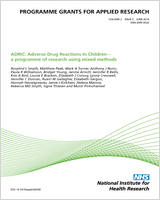From: Identifying potential measures to assess ambulance service performance and quality of care

Developing new ways of measuring the quality and impact of ambulance service care: the PhOEBE mixed-methods research programme.
Programme Grants for Applied Research, No. 7.3.
Turner J, Siriwardena AN, Coster J, et al.
Southampton (UK): NIHR Journals Library; 2019 Apr.
Copyright © Queen’s Printer and Controller of HMSO 2019. This work was produced by Turner et al. under the terms of a commissioning contract issued by the Secretary of State for Health and Social Care. This issue may be freely reproduced for the purposes of private research and study and extracts (or indeed, the full report) may be included in professional journals provided that suitable acknowledgement is made and the reproduction is not associated with any form of advertising. Applications for commercial reproduction should be addressed to: NIHR Journals Library, National Institute for Health Research, Evaluation, Trials and Studies Coordinating Centre, Alpha House, University of Southampton Science Park, Southampton SO16 7NS, UK.
NCBI Bookshelf. A service of the National Library of Medicine, National Institutes of Health.